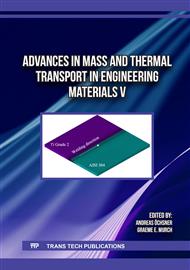[1]
J. Buongiorno, Convective transport in nanofluids, J. Heat Transf. 128, 240–250 (2006)
DOI: 10.1115/1.2150834
Google Scholar
[2]
Y. Ma, R. Mohebbi, M.M. Rashid, Z. Yang, Z. Study of nanofluid forced convection heat transfer in a bent channel by means of lattice Boltzmann method, Phys. Fluids 30, 032001 (2018)
DOI: 10.1063/1.5022060
Google Scholar
[3]
E. Rossi di Schio, M. Celli, A. Barletta. Effects of Brownian Diffusion and Thermophoresis on the Laminar Forced Convection of a Nanofluid in a Channel, J. Heat Transf. 136, 022401 (2014)
DOI: 10.1115/1.4025376
Google Scholar
[4]
Z. Mehrez, M. Bouterra, A. El Cafsi, A. Belghith, Heat transfer and entropy generation analysis of nanofluids flow in an open cavity, Comput. Fluids 88, 363–373 (2013)
DOI: 10.1016/j.compfluid.2013.09.026
Google Scholar
[5]
A. Barletta, E. Rossi di Schio, M. Celli, Convection and instability phenomena in nano-fluid-saturated porous media. Heat Transfer Enhancement with Nanofluids, CRC Press, Boca Raton, FL, 341-364 (2015).
DOI: 10.1201/b18324-15
Google Scholar
[6]
H. Nemati, M. Farhadi, K. Sedighi, E. Fattahi, E., A.A.R. Darzi, Lattice Boltzmann simulation of nanofluid in lid-driven cavity, Int. Commun. Heat Mass Transf. 37(10), 1528-1534 (2010)
DOI: 10.1016/j.icheatmasstransfer.2010.08.004
Google Scholar
[7]
E. Rossi di Schio, A.N. Impiombato, A. Mokhefi, C. Biserni, Theoretical and Numerical Study on Buongiorno's Model with a Couette Flow of a Nanofluid in a Channel with an Embedded Cavity, Appl. Sci. 12(15), 7751 (2022)
DOI: 10.3390/app12157751
Google Scholar
[8]
L. Yang, K. Du, A comprehensive review on the natural, forced, and mixed convection of non-Newtonian fluids (nanofluids) inside different cavities, J. Therm. Anal. Calorim 140, 2033-2054 (2020)
DOI: 10.1007/s10973-019-08987-y
Google Scholar
[9]
G. de Vahl Davis, Natural convection of air in a square cavity: a bench mark numerical solution. International Journal for numerical methods in fluids 3, 249-264 (1983).
DOI: 10.1002/fld.1650030305
Google Scholar
[10]
Y.S. Tian, T.G. Karayiannis, Low turbulence natural convection in an air-filled square cavity: part I: the thermal and fuid fow felds. Int J Heat Mass Transf. 43(6), 849–66 (2000).
DOI: 10.1016/s0017-9310(99)00199-4
Google Scholar
[11]
A.A. Hussein, W. Al-Kouz, M. El Hassan, A.A. Janvekar, A.J. Chamkha, A review of flow and heat transfer in cavities and their applications. The European Physical Journal Plus, 136(4), 353 (2021).
DOI: 10.1140/epjp/s13360-021-01320-3
Google Scholar
[12]
S. Rostami, S. Aghakhani, A. Hajatzadeh Pordanjani, M. Afrand, G. Cheraghian, H.F. Oztop, M.S. Shadloo, A review on the control parameters of natural convection in different shaped cavities with and without nanofluid. Processes, 8(9), 1011, (2020).
DOI: 10.3390/pr8091011
Google Scholar
[13]
A. Mokhefi, E. Rossi di Schio, P. Valdiserri, C. Biserni, Influence of Nanoparticles and Magnetic Field on the Laminar Forced Convection in a Duct Containing an Elastic Fin. WSEAS Transactions on Heat and Mass Transfer 18, 69-83, (2023)
DOI: 10.37394/232012.2023.18.7
Google Scholar
[14]
P. Singh, M. Kumar, Mass transfer in MHD flow of alumina water nanofluid over a flat plate under slip conditions. Alexandria Engineering Journal 54(3), 383-387, 2015.
DOI: 10.1016/j.aej.2015.04.005
Google Scholar


